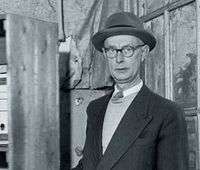Johannes Kleiman
| Johannes Kleiman | |
|---|---|
 Johannes Kleiman | |
| Born |
17 August 1896 Koog aan de Zaan, Netherlands |
| Died |
28 January 1959 (aged 62) Amsterdam, Netherlands |
| Nationality | Dutch |
| Other names | Mr. Koophuis |
| Occupation | Board Worker of Opekta |
Johannes Kleiman (17 August 1896, Koog aan de Zaan – 28 January 1959, Amsterdam) was one of the Dutch citizens who helped hide Anne Frank and her family during the Nazi occupation of the Netherlands. In the published version of Anne's diary, The Diary of a Young Girl, he is given the pseudonym Mr. Koophuis. In some later publications of the diary, the pseudonym was removed, and Kleiman was referred to as Mr. Kleiman.
Kleiman was born in Koog aan de Zaan, Netherlands and met Otto Frank in 1923, when he was trying to establish a branch of the Michael Frank Bank in Amsterdam. Kleiman was registered as a proxy for the bank in May 1924 and given full powers in December of that year when the bank went into liquidation. He was hired by Frank as a bookkeeper for Opekta and Pectacon in 1938, but had become a close friend from about 1933, when the Frank family fled to the Netherlands to escape Nazi persecution in Germany.
Johannes Kleiman became a member of the board of Opekta and the company was established at his home address for the next five months until it moved to Prinsengracht 263 at the end of 1940. Johannes Kleiman officially joined as bookkeeper for both Opekta and Pectacon, with Victor Kugler and secretary Bep Voskuijl for Pectacon, and Otto Frank and his secretary Miep Gies for Opekta.
In August 1944 he was arrested with Victor Kugler by the Gestapo after an unknown informant alerted the authorities to their aiding and concealment of Jews in the premises on the Prinsengracht. After interrogation at the Gestapo Headquarters he and Kugler were transferred to a prison on the Amstelveenseweg for Jews and 'political prisoners' awaiting deportation. He was imprisoned in the Amersfoort labour camp before he was released by special dispensation of the Red Cross, due to ill-health. In all, he was a prisoner of the Nazis for about six weeks.
After the publication of Anne Frank's diary, which detailed her two years in hiding, Kleiman regularly took journalists and visitors around the former hiding place, which had been vacated in the early 1950s. He became very involved in the establishment of the Anne Frank Foundation on 3 May 1957 but did not live to see the building open as a museum in 1960. He died, behind his desk, on 28 January 1959. Otto was devastated about this loss.
References and further reading
- The Diary of Anne Frank: The Revised Critical Edition, Anne Frank, edited by David Barnouw and Gerrold Van der Stroom, translated by Arnold J. Pomerans, compiled by H. J. J. Hardy, second edition, Doubleday, 2003.
- Anne Frank Remembered, Miep Gies with Alison Leslie Gold, Simon and Schuster, 1988.
- Roses from the Earth: the Biography of Anne Frank, Carol Ann Lee, Penguin, 1999.
- Anne Frank: the Biography, Melissa Muller, afterword by Miep Gies, Bloomsbury, 1999.
- The Footsteps of Anne Frank, Ernst Schnabel, Pan, 1988.
- The Hidden Life of Otto Frank, Carol Ann Lee, Penguin, 2002.